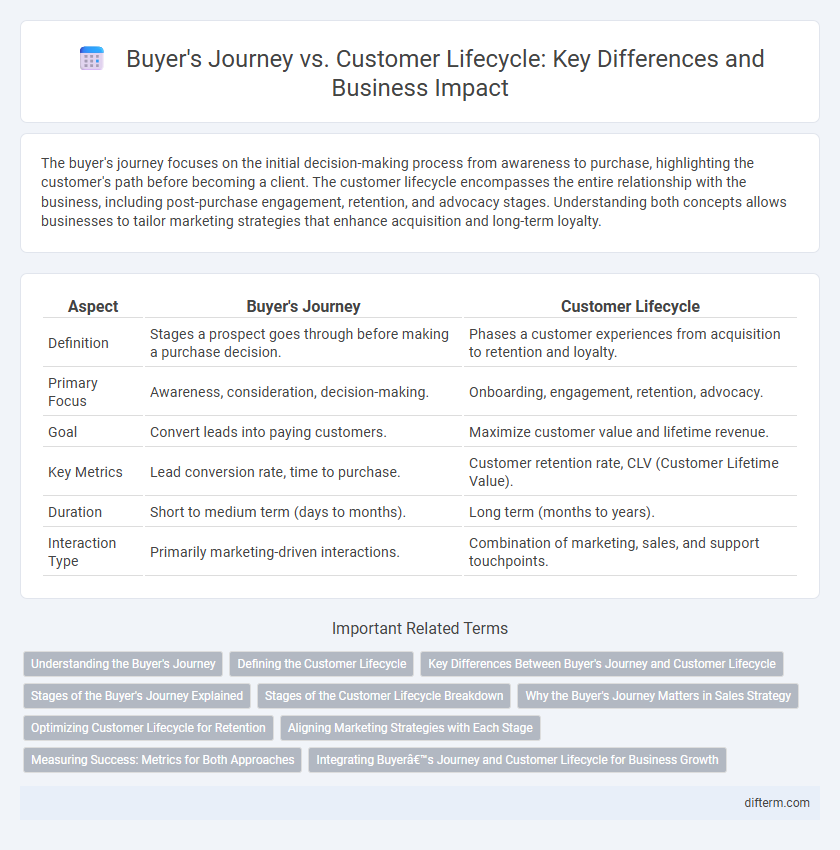The buyer's journey focuses on the initial decision-making process from awareness to purchase, highlighting the customer's path before becoming a client. The customer lifecycle encompasses the entire relationship with the business, including post-purchase engagement, retention, and advocacy stages. Understanding both concepts allows businesses to tailor marketing strategies that enhance acquisition and long-term loyalty.
Table of Comparison
| Aspect | Buyer's Journey | Customer Lifecycle |
|---|---|---|
| Definition | Stages a prospect goes through before making a purchase decision. | Phases a customer experiences from acquisition to retention and loyalty. |
| Primary Focus | Awareness, consideration, decision-making. | Onboarding, engagement, retention, advocacy. |
| Goal | Convert leads into paying customers. | Maximize customer value and lifetime revenue. |
| Key Metrics | Lead conversion rate, time to purchase. | Customer retention rate, CLV (Customer Lifetime Value). |
| Duration | Short to medium term (days to months). | Long term (months to years). |
| Interaction Type | Primarily marketing-driven interactions. | Combination of marketing, sales, and support touchpoints. |
Understanding the Buyer's Journey
Understanding the buyer's journey involves mapping the stages prospects go through from awareness to decision-making, which helps tailor marketing strategies effectively. Unlike the broader customer lifecycle that encompasses post-purchase engagement and loyalty, the buyer's journey concentrates on the pre-purchase phases: awareness, consideration, and decision. Optimizing content at each of these stages increases conversion rates by addressing specific buyer needs and pain points.
Defining the Customer Lifecycle
The customer lifecycle encompasses the entire relationship between a business and its customer, from initial awareness to post-purchase loyalty and advocacy. This lifecycle includes stages such as acquisition, retention, and re-engagement, aiming to maximize customer lifetime value and satisfaction. Understanding the customer lifecycle enables businesses to tailor marketing strategies and optimize touchpoints for sustained growth and enhanced customer experience.
Key Differences Between Buyer's Journey and Customer Lifecycle
The buyer's journey focuses on the stages a potential customer goes through before making a purchase, including awareness, consideration, and decision. The customer lifecycle encompasses the ongoing relationship with a customer post-purchase, including retention, loyalty, and advocacy phases. Key differences include the buyer's journey targeting prospects prior to sale, while the customer lifecycle manages engagement and value optimization after the sale.
Stages of the Buyer's Journey Explained
The Buyer's Journey consists of three key stages: Awareness, Consideration, and Decision, each representing a critical phase in how potential customers identify and evaluate solutions. During the Awareness stage, prospects recognize a problem or need, while in the Consideration stage they research and compare different options. The Decision stage marks the moment when buyers select a product or service, which directly influences marketing strategies targeting these specific touchpoints to optimize conversion and engagement.
Stages of the Customer Lifecycle Breakdown
The Customer Lifecycle encompasses five key stages: Awareness, Consideration, Purchase, Retention, and Advocacy, each crucial for sustaining long-term business growth. During Awareness, potential customers recognize a need, while Consideration involves evaluating solutions, leading to the Purchase decision. Retention focuses on engaging customers post-purchase through personalized experiences, and Advocacy encourages satisfied customers to promote the brand, driving organic growth.
Why the Buyer's Journey Matters in Sales Strategy
Understanding the buyer's journey is crucial in sales strategy because it maps the stages a potential customer goes through before making a purchase decision, enabling targeted and personalized engagement. Aligning sales tactics with the buyer's journey increases conversion rates by addressing specific needs and pain points at each phase, from awareness to consideration and decision. Integrating this framework with the broader customer lifecycle ensures sustained relationships and maximizes lifetime value through continuous, relevant communication.
Optimizing Customer Lifecycle for Retention
Optimizing the customer lifecycle enhances retention by aligning engagement strategies with each phase, from acquisition to loyalty. Businesses increase lifetime value by personalizing experiences, anticipating customer needs, and delivering consistent post-purchase support. Leveraging data analytics and automated touchpoints drives targeted interventions that reduce churn and foster long-term relationships.
Aligning Marketing Strategies with Each Stage
Mapping marketing strategies to the buyer's journey phases--awareness, consideration, and decision--ensures targeted messaging resonates with prospects' evolving needs. Integrating customer lifecycle stages--acquisition, retention, and loyalty--enables personalized engagement that fosters long-term relationships and maximizes lifetime value. Businesses achieving alignment between these frameworks optimize conversion rates and enhance customer experience across all touchpoints.
Measuring Success: Metrics for Both Approaches
Measuring success in the buyer's journey involves tracking conversion rates, time to purchase, and lead engagement to optimize each stage from awareness to decision. In contrast, customer lifecycle metrics emphasize customer retention rates, lifetime value (CLV), and churn rates to maximize long-term profitability and loyalty. Combining insights from both approaches enables businesses to align acquisition strategies with retention efforts for sustainable growth.
Integrating Buyer’s Journey and Customer Lifecycle for Business Growth
Integrating the buyer's journey and customer lifecycle enhances business growth by aligning marketing strategies with customer needs at every stage, from awareness to loyalty. This synergy enables personalized engagement, improved customer retention, and optimized sales funnels. Leveraging data-driven insights throughout these processes increases customer lifetime value and maximizes return on investment.
Buyer's journey vs Customer lifecycle Infographic

 difterm.com
difterm.com